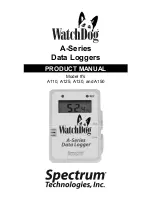
9
MAN-147-0018-A
2.6.
I
NSTALLATION
A
CCESSORIES
Accessories (antenna and brackets for mounting the unit) are available to suit various
installation situations; discuss availability with your HWM representative.
2.7.
C
OMMUNICATIONS
I
NTERFACES AND
P
ROGRAMMING
C
ABLES
To communicate with the Multilog2 logger, a programming cable is required. There are
two connector options available in the logger family for making this connection (10-pin
or 6-pin); only one of these alternatives will be fitted. Use a programming cable that
matches the connector type on the logger.
On Multilog2, the connectors used for communications are frequently shared; they also
include the connections required for fitting an external battery (see section 2.2).
Because of space limitations, the label may not indicate this (e.g., It may simply be
labelled
“COMMS”
).
A typical connector used for communications and its matching communications cable is
shown in Figure 3.
The connector of the communications cable will only include the pins required for
communications purposes.
To use the communications cable, temporarily remove any existing connector, and
re-connect it when finished. Alternatively, an adaptor (Y-cable) can be inserted to be
able to support the logger using both functions together.
Attach the Comms cable to the logger, and then complete the connection to the IDT
host using one of the methods described in section 2.8.
Examples of suitable programming cables are given below:
•
10-pin : COM AEUSB (USB to RS232 comms cable).
CABA2075
(direct USB comms cable).
•
6-pin : CABA8585
(direct USB comms cable).
Figure 3. A typical Multilog2 COMMS connector and an example COMMS cable (with USB-A)













































